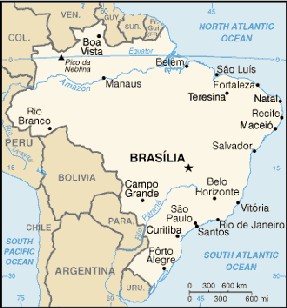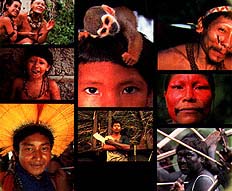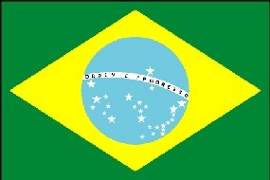Basic Facts

Location: Eastern South America, bordering the Atlantic Ocean.
Area: 8,511,965 sq km (3,286,600 sq mi). Slightly smaller than the U.S., but larger than the 48 contiguous states.
Population: 201,032,714 (2013)
Capital: Brasília
Language: Portuguese
Government: Federal Republic, consisting of 26 states and a Federal District, with elected president and bicameral legislature and supreme court with justices appointed by president and confirmed by legislature. Similar structure on state and municipal levels.
Date of Independence: Sept. 7, 1822 (from Portugal).
Climate: Mostly tropical, temperate in south.
Highest elevation: Pico da Neblina, 3,014 m (9888 ft).
History
The first landing by Europeans was in the year 1500 by Pedro Alvares Cabral, at what is now the city of Porto Seguro in the state of Bahia. His voyage was soon followed by other Portuguese explorers. At the time, the most important exploitable resource was a type of wood used to produce red and purple dyes, called pau-brasil. It was from the name of this wood that the country eventually got its name.
In 1530, Portugal sent the first actual colonists to the newly discovered territory, and before long villages that eventually became the cities of São Vicente and Salvador were founded. As more and more land was settled, the Portuguese government began to realize the need for organized administration. As a first step, by the middle of the 16th century the Crown created a number of hereditary fiefs, some larger than Portugal itself.
In 1578, when King Sebastian of Portugal died, King Philip II of Spain claimed the Portuguese throne, and for a period of 60 years the two countries were united as one. As a result, during this period the boundaries in South America that had previously prevented Portuguese expansion were removed, and during this time what eventually became the nation of Brazil expanded westward.
After Portugal freed itself from Spanish rule in 1640, the Portuguese succeeded in establishing their claim to what had formerly been Spanish territory in South America.
In 1690, gold was discovered. Not only did this discovery draw thousands of colonists away from the coastal regions, but it also spurred immigration. Most of the gold was shipped to Portugal, but it did not all remain there. In the early 1700s England supplied textile products to Portugal, which were paid for with Brazilian gold. This very same gold ended up helping to finance the Industrial Revolution.
Eventually, the gold rush was followed by an even more important source of wealth—coffee. Even today, Brazilian coffee is recognized as being among the world's best. And in Brazil itself, in just about any place of business you enter you will be offered cafezinho, small cups of strong, sweet espresso that has literally become a national symbol.
During the Napoleonic wars in Europe, the king of Portugal, Dom João VI, sailed for Brazil and made Rio de Janeiro the capital of the United Kingdom of Portugal, Brazil and the Algarve. Later, when he returned to Portugal, he left his son Pedro behind to rule the colony. In 1822, Dom Pedro I pulled out his sword and cried, “Independência ou morte!” (independence or death). Portugal, too weak at the time for a fight, did not contest the matter, and so Brazil became an independent empire.
In 1889 a military coup, supported by powerful members of the coffee aristocracy, overthrew the Brazilian Empire and founded the modern Republic of Brazil. For the next 40 years Brazil was ruled by a series of military and civilian presidents.
In 1930 the military assumed direct power after global economic crises weakened the coffee planters' hold on the government. They installed Getúlio Vargas as president, and his regime dominated until 1954 when Juscelino Kubitschek assumed the office. Kubitschek is perhaps best known for building Brasília, a totally planned city which became the national capital.
In 1964 the military again took power and ruled the country until 1989, when the current constitution was put in place and a new civilian president elected. The first president, Fernando Collor de Mello, did not complete his term of office. He was impeached at the end of 1992 and peaceably removed from office and succeeded by the vice president, Itamar Franco. In the election of 1994, Fernando Henrique Cardoso was elected president, then re-elected again in 1998. Since then, further presidents have been elected and served normal terms in a currently stable government.
The People
According to the 2010 census, the population of Brazil is 47.73% European white, 43.13% multiracial, 7.61% African black, 1.09% Asian, and 0.43% indigenous.
Although once a Portuguese colony, the culture of Brazil reflects far more than just Portuguese influence. Settlers from other parts of Europe, such as Germany and Italy, along with considerable numbers of Middle Eastern and Asian immigrants as well as the black and indigenous populations, have also lent their particular flavor. Brazil is truly a melting pot.
It is impossible to say that there is any one unique cultural identity that represents all Brazilians. Brazil is a large nation and there is much regional diversity. Idiomatic expression, food, dress and much more vary across the country. Still, there is much nationally in common.
The staples of Brazilian diet are rice and beans with farinha (manioc flour), usually combined with meat, fish or poultry and vegetables. One popular dish, called feijoada, is almost a symbol of Brazilian food. It consists basically of beans, meat, and fiery spices. There are many varieties. Another very popular food type is the salgado. The term is actually a generic catch-all for a number of small snack-type items, usually consisting of some type of fried flour or bread containing meat, cheese, vegetables, etc. Salgados can be found at snack bars called lanchonetes, located just about anywhere, and are often sold on the street and in restaurants as well.
It is impossible to imagine Brazil without music. Some of the best known Brazilian varieties include the samba and the bossa nova. Samba is still immensely popular, and makes up a large part of Carnaval, a national Brazilian festival that comes from the same roots as Mardi Gras. In addition, there are many modes of modern Brazilian music, such as Música Popular Brasileira (Popular Brazilian Music), sertaneja, and more. Many Brazilian artists are internationally known.
Officially, Brazil is a Catholic country, the largest in the world. However, Protestant denominations are making large inroads among the population. Additionally, many non-Christian religions can be found in Brazil, including African cults and Eastern philosophies.
Lastly, it is impossible to talk about the people and culture of Brazil without mentioning soccer. Soccer, or futebol, as it is known here, is a national passion. Children learn to dribble soccer balls before they are old enough to begin school. Soccer fields are found everywhere, in the city and the country. Even indigenous villages, whatever their differences, have one thing in common: a soccer field. During major matches, people light fireworks to celebrate goals, even if they're only watching on TV. And during the World Cup, which Brazil has won five times—more than any other country—the passion rises to a frenzy. And when Brazil wins the cup, it's party time!
The Indigenous People
Brazil is home to a large number of indigenous peoples, descended from several different original groups that migrated into the Americas thousands of years ago. Like Native Americans in the United States and Canada, their origins are probably diverse, the result of several different migrations at different points in history. The majority are clearly related to the Asiatic peoples of the Far East. Postulated methods of migration are also diverse, ranging from crossing the Bering Strait at a time in history when it was above water, to various sea voyages, possibly from both the Far East and Africa. Intermarriage over the millennia has further clouded the picture, along with language and culture drift and divergence.

At one time the indigenous population of Brazil was much larger. Sadly, when Europeans came over they brought with them something that proved deadly to many of the native inhabitants of the Americas: disease. For example, measles nearly wiped out at least one people group back in the 40's. Additionally, exploitation by white settlers has further served to decimate these people. Fortunately, things have changed, and these days the Brazilian government works to protect the indigenous population of the country.
Today, FUNAI (FUndação NAcional do Índio, or National Indian Foundation) is the principal governmental organization dedicated to protecting the indigenous people of Brazil. Organizations and individuals who wish to work with or even visit indigenous areas must have their permission, although according to law, the final authority lies with the indigenous groups themselves. More and more of the indigenous people are integrating into general Brazilian society, and even in the aldeias (villages), many have electrical power and access to cell phone service. Some tribes have their own web sites, and a large number of the people use computers regularly.
In spite of modernization, most indigenous cultures still maintain a clear distinction from the national Brazilian culture, with their own worldview and placing value on their traditional stories, dances, ceremonies, etc. However, among some groups this is starting to break down among the current younger generation, many of whom wish to assimilate into the national culture. Sadly, a couple of the things most readily adopted from the surrounding Brazilian population are alcohol and tobacco.
Indigenous religious beliefs are basically animistic, a system involving various spirits which must be appeased in order to obtain life's basic necessities and to avoid untimely death. This is a very common type of belief system found in all parts of the world. With the coming of European settlers, many indigenous people converted to Catholicism, as well as other branches of the Christian faith. Today, followers of both traditional and Christian faiths can be found in most tribes, along with some who profess little or no religious belief. This presence of mixed beliefs differs very little from most populations around the world.
Indigenous cultures have influenced Brazilian culture, and many city and other place names are indigenous in origin.
The Language
The national language of Brazil is Portuguese. Sadly, a lot of people don't realize this and simply assume that because Brazil is located in South America they must speak Spanish. (And Brazil isn't the only non Spanish speaking country in South America. There are three more; one speaks French, another Dutch, and the third English!) I can still remember seeing an interview on television with someone sent down from the United States for some forgotten reason. The person spoke Spanish. At the time I remember wondering if Brazilians considered it an insult.
Portuguese is not “Spanish spoken badly”, or “Spanish spoken through the nose”, or “Spanish spoken with mashed potatoes in your mouth”. Portuguese is a unique language. Like Spanish, it is a Romance language, descended from Latin, and is actually quite closely related. Native speakers of Portuguese have little trouble understanding Spanish. It is a bit more difficult going the other direction, though, because Portuguese introduces additional vowel sounds not present in Spanish.
Spanish vowels are a as in “father”, e as in “grey”, i as in “ski”, o as in “go” and u as in “flu”. Portuguese adds an “open” version of e and o, as in “bet” and “dog”.
Learning the language is far more complicated than simply learning a vocabulary and a grammar. As I discovered in my studies of Brazilian Portuguese, it is impossible to master another language unless you also learn to understand the culture in which it is spoken. The two are closely interrelated. In order to learn Portuguese well it is necessary to live with the Brazilian people, to learn how they live and work and play.
Indigenous Languages
The indigenous peoples of Brazil have their own languages, which they spoke long before Europeans ever came to the Western Hemisphere. These languages are not at all related to either English or Portuguese, both of which are European and belong to the same language family. Nor do the indigenous people all speak the same language, either. There are a number of language families, no doubt a result of various different migrations in the past which brought people groups of different ethnic origins into the Americas. Over the millennia these languages have further fractured, to the point where even speakers of fairly closely related languages have difficulty understanding one another.
The structures of indigenous languages are quite different from those of European languages. Sentences are formed differently. Words are often grouped in classes that differ markedly from those of English or Portuguese. Even the phonology—the sound system of a language—is different. Some sounds that exist in European languages are often not found in native languages, and these languages in turn have phonemic sounds—that is, sounds that carry meaning and are not simply variations—not found in English or any related language. Yet these languages are just as fully capable of expressing any idea conceivable to man as the ones that we are familiar with. This is yet another example of the tremendous diversity created into human beings.
Today, many indigenous languages are endangered. The dominance of the national culture and language has had a negative effect on many of the native groups, to the point where some have abandoned their own language and now speak only Portuguese. In many other groups, the older generation still speaks primarily their indigenous language, while the younger generation prefers Portuguese. Fortunately, there are still quite a few groups who maintain their individual identity and continue to embrace their indigenous culture and language.
Tourism
Brazil is a big country. And as such, there is a lot to see. Tourism is a major industry in this country, for both natives and foreign visitors. Whether you like historical places, cities or outdoors and nature, there is something for you. And although Portuguese is the national language, tour guides are readily available who speak other major languages, such as English and Spanish. Brazilians are proud of what their country has to offer.
Rio de Janeiro is a popular tourist center, especially during the time of Carnaval. Carnaval is essentially the same as Mardi Gras in the United States, only more extravagant. Instead of being celebrated only in one city, it is celebrated all over the nation. Rio is merely one of the main places that visitors go to experience it.
Additionally, Rio is a historic city that was the capital of Brazil for a long time, until the seat of government was moved to Brasília in the middle of the last century. Such sites as Morro do Pão de Açucar (Sugarloaf Mountain), Cristo Redentor (Christ the Redeemer), and of course, the famous beaches such as Copacabana draw huge numbers of visitors every year.
If you enjoy nature and the outdoors, you won't want to miss the Pantanal. This is a swampy region in the central part of the country famous for eco-tourism. Many visitors come every year to see the birds and other wildlife. Tours are readily available, as is lodging within the region.
Another famous place for enjoying nature is Parque Nacional Foz do Iguaçu (Foz do Iguaçu National Park), located near the small city of Foz do Iguaçu where the three countries of Brazil, Argentina and Paraguay come together. There is plenty of lodging in the city, and local bus service will take you right to the Park entrance. Once inside, you can catch the bus that will take you through the forest all the way to the cataracts, with several stops along the way where you are welcome to get off and explore. Another bus will soon be along so that you can continue. The Cataracts of Iguaçu is the waterfall with the largest volume of water in the world. In addition, there are nice hiking trails and plenty of wildlife along the way, and a nice restaurant right by the falls themselves.
And while you are in Foz do Iguaçu, don't forget to take a trip out to see the hydroelectric station at Itaipu. Again, a city bus will take you right to the entrance. There are regular tours every hour or two, and professional tour guides who speak excellent English and Spanish. The tour is quite thorough, definitely worth taking. Itaipu is one of the largest hydroelectric installations in the world in power production, and since it straddles the border between Brazil and Paraguay, half of the power produced goes to each country.
And there is plenty more. Beaches all along the coast (the ones in the Northeast are the best and most visited). Interior towns that are more heavily visited by native Brazilians than by foreigners, yet definitely worth the trip if you can find out about them. Gem trade draws many who wish to purchase precious stones; Brazil is one of the largest producers of such stones. Even the Amazon River draws those who want to experience the jungle.
As I said, it's a big country. Find what you like to do, and come!


